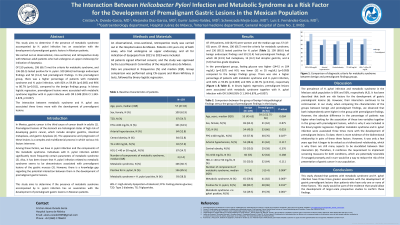Sunday Poster Session
Category: Stomach
P1617 - The Interaction Between Helicobacter Pylori Infection and Metabolic Syndrome as a Risk Factor for the Development of Premalignant Gastric Lesions in the Mexican Population
Sunday, October 27, 2024
3:30 PM - 7:00 PM ET
Location: Exhibit Hall E

Has Audio

Cristian A. Oviedo Garza, MD
Hospital Juarez de México
Mexico City, Distrito Federal, Mexico
Presenting Author(s)
Cristian A. Oviedo Garza, MD1, Alejandra Diaz Garcia, MD1, Eumir Juarez Valdez, MD1, Scherezada Mejia Loza, MD1, Luis E. Fernandez Garza, MD2
1Hospital Juarez de México, Mexico City, Distrito Federal, Mexico; 2Instituto Mexicano del Seguro Social, Mexico City, Nuevo Leon, Mexico
Introduction: Despite the individual relevance of Helicobacter pylori infection and metabolic syndrome in gastrointestinal and metabolic health, there is a knowledge gap regarding the potential interaction between them in the development of premalignant gastric lesions. This study aims to determine if the presence of H. pylori infection accompanied with metabolic syndrome has an association with the development of premalignant gastric lesions in Mexican patients.
Methods: An observational, cross-sectional, retrospective study was carried out in the Hospital Juárez de México. Patients ≥ 18 years old, of both sexes, who had undergone an upper endoscopy, and all for indication of dyspepsia from 2021 to 2023 were included. Data are presented in frequencies (%) and median (IQR). Group comparison was performed using Chi-square and Mann-Whitney U tests, followed by binary logistic regression.
Results: Of 159 patients, 100 (62.9) were women and the median age was 57 (47-65) years. Of these, 106 (66.7) met the criteria for metabolic syndrome, and 136 (85.5) tested positive for H. pylori. 109 (68.6) had benign endoscopic findings and 50 (31.4) had premalignant findings, of which 38 (23.9) had metaplasia, 13 (8.2) had atrophic gastritis, and 6 (3.8) had low-grade dysplasia. In the premalignant group, fasting glucose was higher (144.5 vs 104 mg/dL) (p=0.027) and HDL was lower (32 vs 55 mg/dL) (p=0.050) compared to the benign findings group. There was also a higher percentage of patients with metabolic syndrome and H. pylori infection, with 82% vs 59.6% (p=0.005) and 96% vs 80.7% (p=0.011), respectively. In binary logistic regression, premalignant lesions were associated with metabolic syndrome together with H. pylori infection with OR 3.048 (95% CI 1.349-6.878, p=0.007).
Discussion: The prevalence of H. pylori infection and metabolic syndrome in the Mexican adult population is 80% and 44.2%, respectively. It has been described that both pathologies are risk factors for the development of gastric premalignant lesions. However, the study of their interaction continues to be controversial. Within our sample, we were able to observe that the interaction between them was associated 3 times more with the development of premalignant lesions. Therefore, it reinforces the requirement to implement screening measures for both conditions, which are potentially reversible if managed promptly and in turn would be a way to reduce the risk of the presentation of gastric cancer in our population.
Disclosures:
Cristian A. Oviedo Garza, MD1, Alejandra Diaz Garcia, MD1, Eumir Juarez Valdez, MD1, Scherezada Mejia Loza, MD1, Luis E. Fernandez Garza, MD2. P1617 - The Interaction Between <i>Helicobacter Pylori</i> Infection and Metabolic Syndrome as a Risk Factor for the Development of Premalignant Gastric Lesions in the Mexican Population, ACG 2024 Annual Scientific Meeting Abstracts. Philadelphia, PA: American College of Gastroenterology.
1Hospital Juarez de México, Mexico City, Distrito Federal, Mexico; 2Instituto Mexicano del Seguro Social, Mexico City, Nuevo Leon, Mexico
Introduction: Despite the individual relevance of Helicobacter pylori infection and metabolic syndrome in gastrointestinal and metabolic health, there is a knowledge gap regarding the potential interaction between them in the development of premalignant gastric lesions. This study aims to determine if the presence of H. pylori infection accompanied with metabolic syndrome has an association with the development of premalignant gastric lesions in Mexican patients.
Methods: An observational, cross-sectional, retrospective study was carried out in the Hospital Juárez de México. Patients ≥ 18 years old, of both sexes, who had undergone an upper endoscopy, and all for indication of dyspepsia from 2021 to 2023 were included. Data are presented in frequencies (%) and median (IQR). Group comparison was performed using Chi-square and Mann-Whitney U tests, followed by binary logistic regression.
Results: Of 159 patients, 100 (62.9) were women and the median age was 57 (47-65) years. Of these, 106 (66.7) met the criteria for metabolic syndrome, and 136 (85.5) tested positive for H. pylori. 109 (68.6) had benign endoscopic findings and 50 (31.4) had premalignant findings, of which 38 (23.9) had metaplasia, 13 (8.2) had atrophic gastritis, and 6 (3.8) had low-grade dysplasia. In the premalignant group, fasting glucose was higher (144.5 vs 104 mg/dL) (p=0.027) and HDL was lower (32 vs 55 mg/dL) (p=0.050) compared to the benign findings group. There was also a higher percentage of patients with metabolic syndrome and H. pylori infection, with 82% vs 59.6% (p=0.005) and 96% vs 80.7% (p=0.011), respectively. In binary logistic regression, premalignant lesions were associated with metabolic syndrome together with H. pylori infection with OR 3.048 (95% CI 1.349-6.878, p=0.007).
Discussion: The prevalence of H. pylori infection and metabolic syndrome in the Mexican adult population is 80% and 44.2%, respectively. It has been described that both pathologies are risk factors for the development of gastric premalignant lesions. However, the study of their interaction continues to be controversial. Within our sample, we were able to observe that the interaction between them was associated 3 times more with the development of premalignant lesions. Therefore, it reinforces the requirement to implement screening measures for both conditions, which are potentially reversible if managed promptly and in turn would be a way to reduce the risk of the presentation of gastric cancer in our population.
Disclosures:
Cristian Oviedo Garza indicated no relevant financial relationships.
Alejandra Diaz Garcia indicated no relevant financial relationships.
Eumir Juarez Valdez indicated no relevant financial relationships.
Scherezada Mejia Loza indicated no relevant financial relationships.
Luis Fernandez Garza indicated no relevant financial relationships.
Cristian A. Oviedo Garza, MD1, Alejandra Diaz Garcia, MD1, Eumir Juarez Valdez, MD1, Scherezada Mejia Loza, MD1, Luis E. Fernandez Garza, MD2. P1617 - The Interaction Between <i>Helicobacter Pylori</i> Infection and Metabolic Syndrome as a Risk Factor for the Development of Premalignant Gastric Lesions in the Mexican Population, ACG 2024 Annual Scientific Meeting Abstracts. Philadelphia, PA: American College of Gastroenterology.
